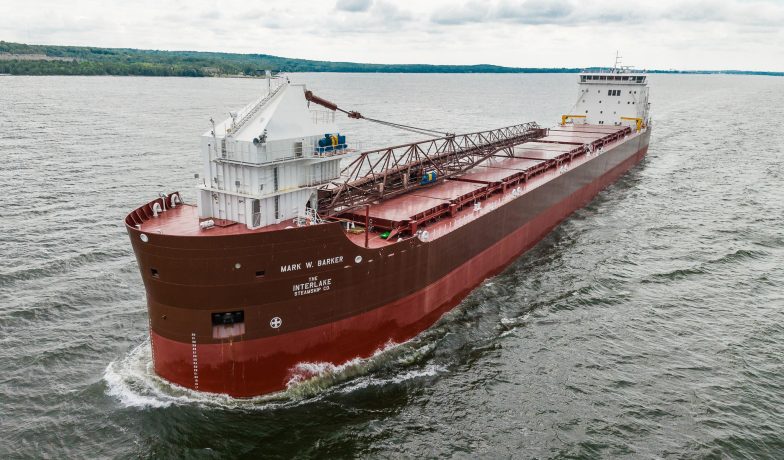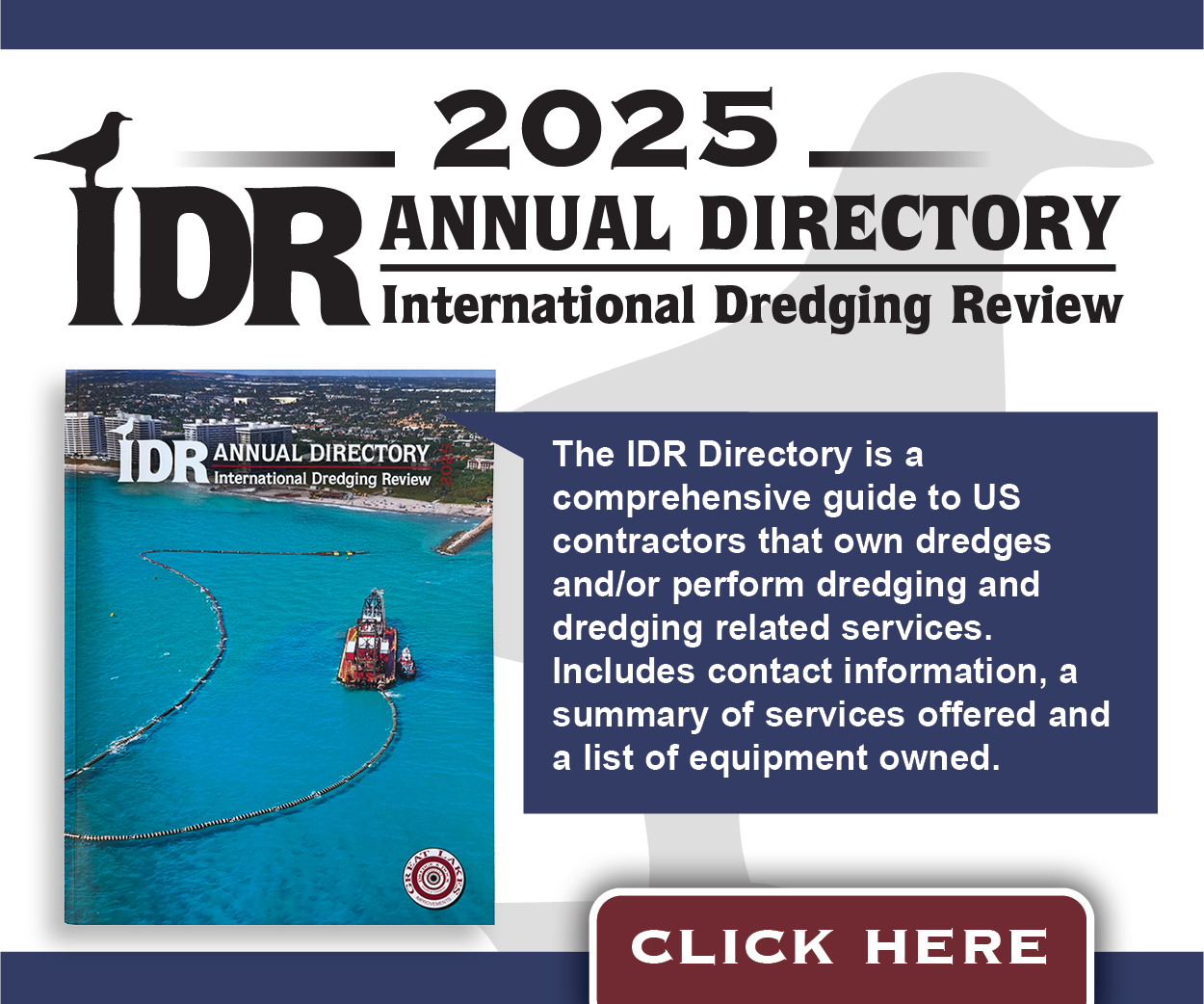First New Laker In A Generation Embarks On Maiden Voyage
The M/V Mark W. Barker has a hull depth of 45 feet and a carrying capacity of 26,000 gross tons. The vessel is named for Interlake’s president and second-generation leader, Mark Barker.
“This is a monumental day for our company and the U.S.-flag fleet as our much-anticipated freighter departs on her first voyage in what will be a long life of service on the Great Lakes,” Barker said of Interlake’s first new-build since 1981.
A new laker is a rare thing, Barker said, with the last new construction laker hitting the water nearly 40 years ago. That makes the M/V Mark W. Barker a special project.
“On the Great Lakes, we operate in pretty unique water in that we’re fresh water, so we have pretty long-lived assets,” Barker said. “We have ships running that were built in the ’50s.”
Working in fresh water gives lakers unusual longevity, which makes repowering and modernizing existing ships more common than building new, especially for the U.S. fleet. There have been new articulated tug barges, but not so much lakers.
Vessel of the Future
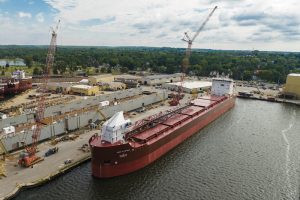 The M/V Mark W. Barker brings some new design elements to the Interlake fleet that are also rarely seen in the broader U.S. Great Lakes fleet. Interlake built the M/V Mark W. Barker with a particular customer’s needs in mind. That customer’s dock has length, width and depth limitations, so Interlake’s naval architecture team looked at vessel features that would best serve that facility.
The M/V Mark W. Barker brings some new design elements to the Interlake fleet that are also rarely seen in the broader U.S. Great Lakes fleet. Interlake built the M/V Mark W. Barker with a particular customer’s needs in mind. That customer’s dock has length, width and depth limitations, so Interlake’s naval architecture team looked at vessel features that would best serve that facility.
“We started with how do we pull as much cargo from their dock as possible to make it economical for them,” Barker said. “That determined the vessel size. We also asked how do we carry the most amount of cargo.”
Those questions led Interlake to design a “river class” laker with two main features outside the norm: a forward boom rather than an aft-mounted crane and a square cargo hold rather than a V-shaped hold.
Most lakers carry cargoes that are free-flowing like iron ore, stone, salt or coal, Barker said, with conveyor systems that move the cargo ashore or to a hopper. For the M/V Mark W. Barker, the hold design maximizes the amount of cargo the vessel can carry, while the forward boom allows the ship to serve river docks that have limited access.
“We are navigating up some narrow channels and interesting areas and trying to reach locations on people’s docks to place cargo in the most efficient way for them,” Barker said. “Sometimes, having that forward boom lets you reach places you couldn’t get to with an aft boom.”
After departing from Sturgeon Bay the morning of July 27, the M/V Mark W. Barker made a 110-mile journey to Port Inland, Michigan, where the vessel’s crew of 21 loaded stone bound for Muskegon, Michigan. The stone cargo, once delivered, went into read-mix concrete production.
“This new vessel not only brings with it additional cargo carrying capacity and capabilities,” said Brendan P. O’Connor, vice president of marketing and marine traffic for Interlake, “it is the most versatile in our fleet and strategically-sized to navigate into nearly any port on the Great Lakes. The M/V Mark W. Barker will give us unmatched ability for cargo operations and to carry unique project cargoes because of both her square-shaped cargo hold and larger hatch openings. She truly was designed to be a vessel for the future.”
Interlake’s team of naval architects worked with Bay Engineering, also of Sturgeon Bay, for refining the design and preliminary engineering. Bay Engineering and Fincantieri Bay Shipbuilding then did the final design.
According to Interlake, the M/V Mark W. Barker is the first laker to have Tier 4 main engines, a pair of EMD main engines that produce 8,000 total hp. Those engines turn a single four-blade, controllable-pitch propeller through a Lufkin twin-input, single-output gearbox. The ship also features oil-free propeller shaft bearings from Thordon Bearings and 1,000 hp. Kongsberg thrusters on the bow and stern.
The M/V Mark W. Barker’s crew will work 60 days on and 30 days off. The ship is outfitted with both men’s and women’s changing rooms and locker rooms. “We’re trying to make sure we’re adapting for the workforce of the future,” Barker said. “That was an important aspect for us.”
Carrying on a Legacy
Barker said, while the ship itself is a big deal for the Great Lakes maritime industry, it also tells a good story that’s completely American.
“It’s a cool life cycle that this ship is being made from iron ore out of the Mesabi Range in Minnesota, turned into steel in Indiana by U.S. steel workers, and built by U.S. shipyard workers in Wisconsin to go back into business on the Great Lakes carrying all those cargoes,” Barker said. “This is truly an American-built and Great Lakes-built boat.”
And it is a boat that will carry Barker’s name and represent a growing Barker family legacy with Interlake. Barker’s father, James, took the company private in 1987 and continues to serve as chairman. Two other Interlake vessels bear the name of Barker’s father and mother.
“It’s humbling,” Barker said. “It’s not something I looked for. My dad has run this business a long time, and he’s still our chairman. He said, ‘You know, we should name this boat after you, son.’ It’s kind of hard to say no to your 85-year-old father. It’s pretty humbling, and I’m not sure I’m worthy of having a boat named after me, but it’s an absolute honor.”
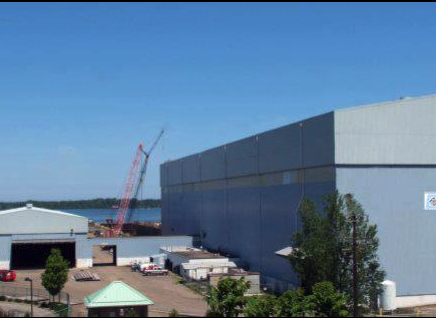
Donjon Marine Acquired by Investment Firm Tallvine
Donjon Marine Co. LLC, which operates a shipyard in the Great Lakes, has been acquired by Miami-based investment firm Tallvine Partners. Donjon Marine was founded in 1964 and operates dredging,... Read More
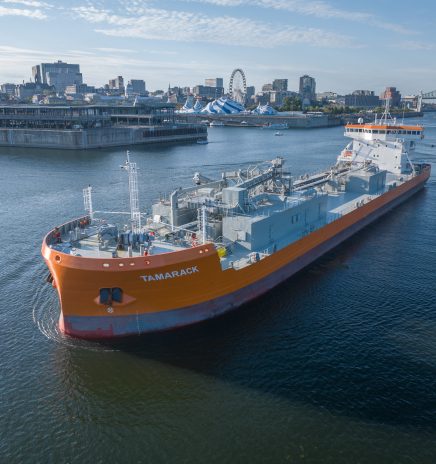
M/V Tamarack is First Newbuild Cement Ship in the Great Lakes in 20 Years
M/V Tamarack arrived at the Port of Montreal on August 22, completing her maiden transatlantic voyage and marking a major milestone in North American shipping. Owned by Eureka Shipping, a joint... Read More

